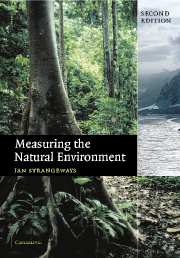Book contents
- Frontmatter
- Contents
- Acknowledgements
- 1 Basics
- 2 Radiation
- 3 Temperature
- 4 Humidity
- 5 Wind
- 6 Barometric pressure
- 7 Evaporation
- 8 Precipitation
- 9 Soil moisture and groundwater
- 10 Rivers and lakes
- 11 Data logging
- 12 Telemetry
- 13 Visibility
- 14 Clouds
- 15 Lightning
- 16 The upper atmosphere
- 17 The oceans
- 18 Cold regions
- 19 Remote sensing
- 20 Atmospheric composition
- 21 Forward look
- Appendix: abbreviations and acronyms
- Index
- References
2 - Radiation
Published online by Cambridge University Press: 05 July 2014
- Frontmatter
- Contents
- Acknowledgements
- 1 Basics
- 2 Radiation
- 3 Temperature
- 4 Humidity
- 5 Wind
- 6 Barometric pressure
- 7 Evaporation
- 8 Precipitation
- 9 Soil moisture and groundwater
- 10 Rivers and lakes
- 11 Data logging
- 12 Telemetry
- 13 Visibility
- 14 Clouds
- 15 Lightning
- 16 The upper atmosphere
- 17 The oceans
- 18 Cold regions
- 19 Remote sensing
- 20 Atmospheric composition
- 21 Forward look
- Appendix: abbreviations and acronyms
- Index
- References
Summary
The day was ending in a serenity of still and exquisite brilliance. Only the gloom in the west, brooding over the upper reaches, became more sombre every minute, as if angered by the approach of the sun. And at last, in its curved and imperceptible fall, the sun sank low, and from glowing white changed to a dull red without rays and without heat, as if about to go out suddenly, stricken to death by the touch of that gloom brooding over a crowd of men.
Joseph Conrad Heart of Darkness (from a boat on the Thames near London).The variable
Integrated over the whole of its radiation spectrum, the sun emits about 74 million watts of electromagnetic energy per square metre. At the mean distance of the earth from the sun, the energy received from the sun at the outer limits of the earth's atmosphere, at right angles to the solar beam, is about 1353 watts per square metre (W m–2) and is known as the solar constant. In fact the energy received is not quite constant but varies over the year by about 3%, because the earth is in an orbit around the sun that is elliptical, not circular. The actual output of the sun itself also varies with time, the most familiar regular rhythm being the 11-year sunspot cycle, although the variations due to this are less than 0.1%. There are other, longer, cycles such as the 22-year double sunspot cycle, and the 80- to 90-year cycles (Burroughs 1994). It is useful to define some terms.
- Type
- Chapter
- Information
- Measuring the Natural Environment , pp. 11 - 30Publisher: Cambridge University PressPrint publication year: 2003



